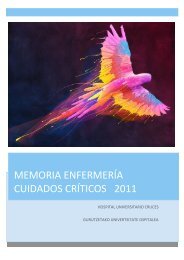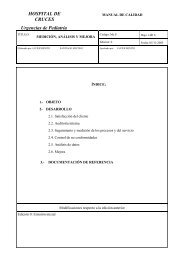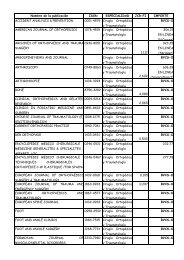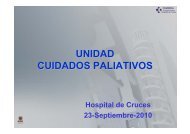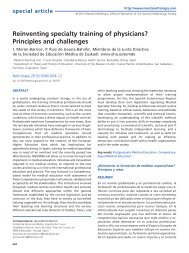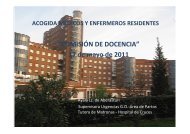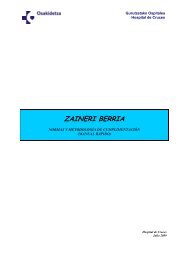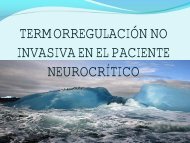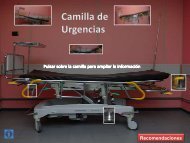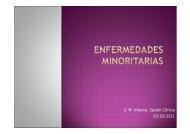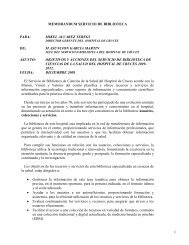The JBI model of evidence-based healthcare - EXTRANET ...
The JBI model of evidence-based healthcare - EXTRANET ...
The JBI model of evidence-based healthcare - EXTRANET ...
Create successful ePaper yourself
Turn your PDF publications into a flip-book with our unique Google optimized e-Paper software.
Blackwell Science, LtdOxford, UKJBRInternational Journal <strong>of</strong> Evidence-Based Healthcare1479-697X2005 <strong>The</strong> Joanna Briggs Institute?? 200538207215Scholarly Paper<strong>The</strong> <strong>JBI</strong> <strong>model</strong> <strong>of</strong> <strong>evidence</strong>-<strong>based</strong> <strong>healthcare</strong>A Pearsonet al.Int J Evid Based Healthc 2005; 3: 207–215SCHOLARLY PAPER<strong>The</strong> <strong>JBI</strong> <strong>model</strong> <strong>of</strong> <strong>evidence</strong>-<strong>based</strong><strong>healthcare</strong>Alan Pearson RN MSc PhD FAAG FRCN, 1,2Rick Wiechula RN BA BN MNSc DNurs, 1,2 Anthea Court 1,2and Craig Lockwood RN BN MNSc 1,21<strong>The</strong> Joanna Briggs Institute, Royal Adelaide Hospital, and 2 Department <strong>of</strong> Clinical Nursing, <strong>The</strong> University <strong>of</strong>Adelaide, Adelaide, South Australia, AustraliaAbstractEvidence-<strong>based</strong> <strong>healthcare</strong> as it is contemporarily conceived is <strong>based</strong> on the view thatclinical decisions should be <strong>based</strong> on the best available scientific <strong>evidence</strong> but recognisingpatient preferences, the context <strong>of</strong> <strong>healthcare</strong> and the judgement <strong>of</strong> the clinician. <strong>The</strong>ongoing debate on the nature <strong>of</strong> <strong>evidence</strong> for practice across all <strong>of</strong> the health pr<strong>of</strong>essionsis influenced by the experience <strong>of</strong> clinicians in everyday practice who, in using the <strong>evidence</strong>,assert that there are diverse sources <strong>of</strong> research-<strong>based</strong> and non-research-<strong>based</strong> <strong>evidence</strong>and that the process <strong>of</strong> <strong>evidence</strong>-<strong>based</strong> practice should be placed within a broader contextthat is grounded in practice; recognises different evidentiary bases; and is directed towardsimproving global health across vasty different practice contexts.We present a developmental framework <strong>of</strong> <strong>evidence</strong>-<strong>based</strong> practice that builds and expandson the work <strong>of</strong> leaders in the field <strong>of</strong> <strong>evidence</strong>-<strong>based</strong> <strong>healthcare</strong>; is contextualised; isinclusive <strong>of</strong> diverse forms <strong>of</strong> <strong>evidence</strong>; and incorporates understandings <strong>of</strong> knowledgetransfer and utilisation. <strong>The</strong> conceptual <strong>model</strong> attempts to situate <strong>healthcare</strong> <strong>evidence</strong> andits role and use within the complexity <strong>of</strong> practice settings globally.Key words: <strong>evidence</strong>-<strong>based</strong> <strong>healthcare</strong>, <strong>evidence</strong>-<strong>based</strong> medicine, <strong>evidence</strong> synthesis,<strong>evidence</strong> transfer, <strong>evidence</strong> utilisation.Correspondence: Pr<strong>of</strong>essor AlanPearson, <strong>The</strong> Joanna BriggsInstitute, Margaret GrahamBuilding, Royal AdelaideHospital, North Terrace,Adelaide, SA 5000, Australia.Email: alan.pearson@adelaide.edu.au© 2005 <strong>The</strong> AuthorsJournal compilation © 2005 <strong>The</strong>Joanna Briggs Institute
208 A Pearson et al.IntroductionEvidence-<strong>based</strong> <strong>healthcare</strong> is gaining increasing acceptancein most Westernised countries and the science <strong>of</strong> <strong>evidence</strong>synthesis is continually evolving and expanding. Over anumber <strong>of</strong> years working as an <strong>evidence</strong>-<strong>based</strong> <strong>healthcare</strong>research group observing – and participating – in the ongoinginternational dialogue, we have explored the nature <strong>of</strong><strong>evidence</strong> in its generic sense and engaged in the development<strong>of</strong> a conceptual framework for <strong>evidence</strong>-<strong>based</strong> practicethat is inclusive <strong>of</strong> diverse sources <strong>of</strong> research-<strong>based</strong> andnon-research-<strong>based</strong> <strong>evidence</strong> and places the process <strong>of</strong><strong>evidence</strong>-<strong>based</strong> practice within a broader context that isboth grounded in practice and directed towards improvingglobal health.Contemporary understandings <strong>of</strong> <strong>evidence</strong>-<strong>based</strong> <strong>healthcare</strong>practice focus on the need for all health pr<strong>of</strong>essionalsto practise in ways that are supported by the most up-todate<strong>evidence</strong> or knowledge available and concur with thedefinition <strong>of</strong> Sackett and colleagues as:<strong>The</strong> conscientious, explicit, and judicious use <strong>of</strong> current best<strong>evidence</strong> in making decisions about the care <strong>of</strong> individualpatients. <strong>The</strong> practice <strong>of</strong> <strong>evidence</strong> <strong>based</strong> medicine means integratingindividual clinical expertise with the best available externalclinical <strong>evidence</strong> from systematic research. 1Sackett and Rosenberg 2 argue for the need to base medicalpractice on the best possible <strong>evidence</strong>; to criticallyappraise research reports for validity and usefulness; and toincorporate the rapidly growing body <strong>of</strong> <strong>evidence</strong> into medicalpractice. <strong>The</strong>y suggest that <strong>evidence</strong>-<strong>based</strong> medicine isconcerned with five linked ideas:1 Clinical and other <strong>healthcare</strong> decisions should be <strong>based</strong>on the best patient population and laboratory-<strong>based</strong><strong>evidence</strong>.2 <strong>The</strong> nature and source <strong>of</strong> the <strong>evidence</strong> to be soughtdepends on the particular clinical question.3 <strong>The</strong> identification <strong>of</strong> the best available <strong>evidence</strong> requiresthe application <strong>of</strong> epidemiological, economic and biostatisticalprinciples plus pathophysiology and personalexperience.4 This identification and appraisal <strong>of</strong> the <strong>evidence</strong> must beacted upon.5 <strong>The</strong>re should be continuous evaluation <strong>of</strong> performance.<strong>The</strong>re are a number <strong>of</strong> <strong>model</strong>s that attempt to representthe components <strong>of</strong> <strong>evidence</strong>-<strong>based</strong> <strong>healthcare</strong> to facilitateunderstanding, analysis, improvement and/or the replacement<strong>of</strong> the process as it is currently conceived, purportedand practised. <strong>The</strong> Star Model <strong>of</strong> Knowledge Transformation,for example, is ‘a simple, parsimonious depiction <strong>of</strong> therelationships between various stages <strong>of</strong> knowledge transformation,as newly discovered knowledge is moved intopractice’. Configured as a simple five-point star, the <strong>model</strong>consists <strong>of</strong> five stages <strong>of</strong> knowledge transformation:• knowledge discovery;• <strong>evidence</strong> summary;• translation into practice recommendations;• integration into practice; and• evaluation. 3Similarly, Dawes and colleagues 4 present five stages <strong>of</strong><strong>evidence</strong>-<strong>based</strong> <strong>healthcare</strong>:• the translation <strong>of</strong> uncertainty to an answerable question;• the systematic retrieval <strong>of</strong> the best <strong>evidence</strong> available;• the critical appraisal <strong>of</strong> <strong>evidence</strong> for validity, clinical relevanceand applicability;• the application <strong>of</strong> results in practice; and• the evaluation <strong>of</strong> performance.Titler and Everett also see the use <strong>of</strong> <strong>evidence</strong> as pivotal tounderstanding the <strong>evidence</strong>-<strong>based</strong> practice approach andcite the Rogers’ diffusion <strong>of</strong> innovation <strong>model</strong> as a usefulconceptual guide. This <strong>model</strong>, when applied to the use <strong>of</strong><strong>evidence</strong>-<strong>based</strong> guidelines, addresses four areas:• the characteristics <strong>of</strong> the guideline;• the users <strong>of</strong> the guideline;• the methods <strong>of</strong> communicating the guideline; and• the social system in which it is being adopted. 5<strong>The</strong> term ‘research utilisation’ is used to describe processesakin to those <strong>of</strong> <strong>evidence</strong>-<strong>based</strong> <strong>healthcare</strong>, such asin the Stetler Model <strong>of</strong> Research Utilisation. <strong>The</strong> StetlerModel applies research findings at the individual practitionerlevel. <strong>The</strong> <strong>model</strong> has six phases: preparation, validation,comparative evaluation, decision-making, translation, andapplication and evaluation. 6–9 Dobrow et al. 10 have developeda conceptual framework for <strong>evidence</strong>-<strong>based</strong> decisionmakingarising out <strong>of</strong> a well-constructed critique <strong>of</strong> thecurrent, dominant view <strong>of</strong> <strong>evidence</strong>-<strong>based</strong> practice. <strong>The</strong>ysuggest that prevailing conceptions <strong>of</strong> <strong>evidence</strong>-<strong>based</strong> practiceare overly focused on ‘. . . a scientific conception <strong>of</strong><strong>evidence</strong> – <strong>evidence</strong> developed through systematic andmethodologically rigorous clinical research, emphasising theuse <strong>of</strong> science while de-emphasising the use <strong>of</strong> intuition,unsystematic clinical experience, patient and pr<strong>of</strong>essionalvalues, and pathophysiological rationale’. This, they argue,is too narrow and ignores other sources <strong>of</strong> <strong>evidence</strong>or relevance to clinical decision-making. <strong>The</strong>ir ‘<strong>model</strong>’describes axes <strong>of</strong> <strong>evidence</strong>-<strong>based</strong> decision-making todescribe the relationship between <strong>evidence</strong> and context.‘Evidence axis’ describes the scientific <strong>evidence</strong> sourced toinform a clinical decision and ‘context axis’ describes© 2005 <strong>The</strong> AuthorsJournal compilation © 2005 <strong>The</strong> Joanna Briggs Institute
<strong>The</strong> <strong>JBI</strong> <strong>model</strong> <strong>of</strong> <strong>evidence</strong>-<strong>based</strong> <strong>healthcare</strong> 209contextual factors that inform the decision. <strong>The</strong>y assert that<strong>evidence</strong>-<strong>based</strong> practice is currently focused on the <strong>evidence</strong>axis and pays little attention to the way that context impactson <strong>evidence</strong>-<strong>based</strong> decision-making.Our <strong>model</strong> <strong>of</strong> <strong>evidence</strong>-<strong>based</strong> <strong>healthcare</strong> is developmentaland, building on frameworks that have evolved, it has beenconstructed out <strong>of</strong> our experience with the <strong>evidence</strong>-<strong>based</strong>practice field; our emerging international work with theJoanna Briggs Institute and the international CollaboratingCentres <strong>of</strong> the Joanna Briggs Collaboration; our involvementin disseminating, implementing and evaluating <strong>evidence</strong><strong>based</strong>guidelines in clinical settings; and our examination <strong>of</strong>the scientific and pr<strong>of</strong>essional literature.<strong>The</strong> <strong>JBI</strong> <strong>model</strong> <strong>of</strong> <strong>evidence</strong>-<strong>based</strong><strong>healthcare</strong><strong>The</strong> <strong>JBI</strong> <strong>model</strong> <strong>of</strong> <strong>evidence</strong>-<strong>based</strong> <strong>healthcare</strong> conceptualises<strong>evidence</strong>-<strong>based</strong> practice as clinical decision-making thatconsiders the best available <strong>evidence</strong>; the context in whichthe care is delivered; client preference; and the pr<strong>of</strong>essionaljudgement <strong>of</strong> the health pr<strong>of</strong>essional. <strong>The</strong> <strong>model</strong> depicts thefour major components <strong>of</strong> the <strong>evidence</strong>-<strong>based</strong> <strong>healthcare</strong>process as:1 <strong>healthcare</strong> <strong>evidence</strong> generation;2 <strong>evidence</strong> synthesis;3 <strong>evidence</strong> (knowledge) transfer; and4 <strong>evidence</strong> utilisation.Each <strong>of</strong> these components is <strong>model</strong>led to incorporate theiressential elements; and the achievement <strong>of</strong> improved globalhealth is conceptualised as both the goal and end-point <strong>of</strong>any or all <strong>of</strong> the <strong>model</strong> components and the raison d’êtreand driver <strong>of</strong> <strong>evidence</strong>-<strong>based</strong> <strong>healthcare</strong> (Fig. 1).Evidence-<strong>based</strong> <strong>healthcare</strong> is represented as a cyclical processthat derives questions, concerns or interests from theidentification <strong>of</strong> global <strong>healthcare</strong> needs by clinicians orpatients/consumers and then proceeds to address thesequestions by generating knowledge and <strong>evidence</strong> toFigure 1 Conceptual <strong>model</strong> <strong>of</strong> <strong>evidence</strong>-<strong>based</strong> <strong>healthcare</strong>.© 2005 <strong>The</strong> AuthorsJournal compilation © 2005 <strong>The</strong> Joanna Briggs Institute
210 A Pearson et al.effectively and appropriately meet these needs in ways thatare feasible and meaningful to specific populations, culturesand settings. This <strong>evidence</strong> is then appraised and synthesisedand transferred to service delivery settings and healthpr<strong>of</strong>essionals who then utilise it and evaluate its impact onhealth outcomes, health systems and pr<strong>of</strong>essional practice.Healthcare <strong>evidence</strong> generation<strong>The</strong>re is ongoing debate on the meaning <strong>of</strong> <strong>evidence</strong> whenattaching this epithet to <strong>healthcare</strong>. According to Humphris,the term ‘<strong>evidence</strong> <strong>based</strong>’ in <strong>healthcare</strong> ‘implies the use andapplication <strong>of</strong> research <strong>evidence</strong> as a basis on which to make<strong>healthcare</strong> decisions, as opposed to decisions not <strong>based</strong> on<strong>evidence</strong>’. 11 However, ‘<strong>evidence</strong>’ is a complex concept thatwarrants examination as it means different things to differentpeople. In its most generic sense it is defined as being‘the available facts, circumstances, etc. supporting or otherwisea belief, proposition, etc. or indicating whether a thingis true or valid’. 12 A less common meaning ascribed to<strong>evidence</strong> by Pearsall and Trumble is that <strong>of</strong> clearness orobviousness. 12 From a philosophical standpoint, the concept<strong>of</strong> <strong>evidence</strong> plays a key role in our understanding <strong>of</strong> knowledgeand rationality. Traditionally, ‘one has knowledge onlywhen one has a true belief <strong>based</strong> on very strong <strong>evidence</strong>’. 13Moreover, for belief to be rational it must be <strong>based</strong> onadequate <strong>evidence</strong>, even where that <strong>evidence</strong> is insufficientto ground knowledge. Within the empirical sciences, thestanding <strong>of</strong> a given theory or hypothesis is entirely dependenton the quantity and character <strong>of</strong> the <strong>evidence</strong> in itsfavour. It is the relative weight <strong>of</strong> supporting <strong>evidence</strong>that allows us to choose between competing theories.Within the empirical sciences, the process <strong>of</strong> knowledgegeneration involves testing a hypothesis or a set <strong>of</strong> hypothesesby deriving consequences from it and then testingwhether those consequences hold true by experiment andobservation.<strong>The</strong> term ‘<strong>evidence</strong>’ is used in the <strong>model</strong> to mean thebasis <strong>of</strong> belief; the substantiation or confirmation that isneeded in order to believe that something is true. 14 Healthpr<strong>of</strong>essionals seek <strong>evidence</strong> to substantiate the worth <strong>of</strong> avery wide range <strong>of</strong> activities and interventions and thus thetype <strong>of</strong> <strong>evidence</strong> needed depends on the nature <strong>of</strong> theactivity and its purpose.Evidence <strong>of</strong> ‘feasibility’Feasibility is the extent to which an activity is practical andpracticable. Clinical feasibility is about whether or not anactivity or intervention is physically, culturally or financiallypractical or possible within a given context.Evidence <strong>of</strong> ‘appropriateness’Appropriateness is the extent to which an intervention oractivity fits with or is apt in a situation. Clinical appropriatenessis about how an activity or intervention relates to thecontext in which care is given.Evidence <strong>of</strong> ‘meaningfulness’Meaningfulness is the extent to which an intervention oractivity is positively experienced by the patient. Meaningfulnessrelates to the personal experience, opinions, values,thoughts, beliefs and interpretations <strong>of</strong> patients or clients.Evidence <strong>of</strong> ‘effectiveness’Effectiveness is the extent to which an intervention, whenused appropriately, achieves the intended effect. Clinicaleffectiveness is about the relationship between an interventionand clinical or health outcomes.<strong>The</strong> <strong>healthcare</strong> <strong>evidence</strong> generation component <strong>of</strong> the<strong>model</strong> identifies discourse (or narrative), experience andresearch as legitimate means <strong>of</strong> <strong>evidence</strong> or knowledge generation(Fig. 2).<strong>The</strong> means <strong>of</strong> generation are linked to the purpose <strong>of</strong><strong>evidence</strong> generation in <strong>evidence</strong>-<strong>based</strong> <strong>healthcare</strong> – that is,to establish the feasibility, appropriateness, meaningfulnessor effectiveness <strong>of</strong> an intervention, an activity or a phenomenain relation to both <strong>healthcare</strong> and methods <strong>of</strong> utilisation<strong>evidence</strong> and, thus, changing practices. Any indication thata practice is effective, appropriate, meaningful or feasible –whether derived from experience or expertise or inferenceor deduction or the results <strong>of</strong> rigorous inquiry – is regardedFigure 2 Healthcare <strong>evidence</strong> generation.© 2005 <strong>The</strong> AuthorsJournal compilation © 2005 <strong>The</strong> Joanna Briggs Institute
<strong>The</strong> <strong>JBI</strong> <strong>model</strong> <strong>of</strong> <strong>evidence</strong>-<strong>based</strong> <strong>healthcare</strong> 211as a form <strong>of</strong> <strong>evidence</strong> in the <strong>model</strong>. (<strong>The</strong> results <strong>of</strong> welldesignedresearch studies grounded in any methodologicalposition are seen to be more credible as <strong>evidence</strong> thananecdotes or personal opinion; however, when no research<strong>evidence</strong> exists, expert opinion is seen to represent the ‘bestavailable’ <strong>evidence</strong>).Evidence synthesisEvidence synthesis – the evaluation or analysis <strong>of</strong> research<strong>evidence</strong> and opinion on a specific topic to aid in decisionmakingin <strong>healthcare</strong> – is conceptualised as consisting <strong>of</strong>three elements in the <strong>model</strong>: theory, methodology and thesystematic review <strong>of</strong> <strong>evidence</strong> (Fig. 3).Although the science <strong>of</strong> <strong>evidence</strong> synthesis has developedmost rapidly in relation to the meta-analysis <strong>of</strong> numericaldata linked to theories <strong>of</strong> cause and effect, the further development<strong>of</strong> theoretical understandings and propositions <strong>of</strong>the nature <strong>of</strong> <strong>evidence</strong> and its role in <strong>healthcare</strong> delivery andthe facilitation <strong>of</strong> improved global health is identified as animportant element <strong>of</strong> this component <strong>of</strong> the <strong>model</strong>. Similarly,the increasing, ongoing interest and theoretical workon methods <strong>of</strong> synthesizing <strong>evidence</strong> from diverse sourcesare depicted as an element <strong>of</strong> <strong>evidence</strong> synthesis.<strong>The</strong> third element <strong>of</strong> <strong>evidence</strong> synthesis is the operationalisation<strong>of</strong> methods <strong>of</strong> synthesis through the systematicreview process. This element in the <strong>model</strong> is grounded inthe view that <strong>evidence</strong> <strong>of</strong> feasibility, appropriateness, meaningfulness,effectiveness and economics are legitimate focifor the systematic review process; and that diverse forms <strong>of</strong><strong>evidence</strong> (from experience, opinion and research thatinvolves numerical and/or textual data) can be appraised,extracted and synthesised. 15Figure 3 Evidence synthesis.<strong>The</strong> systematic review and the synthesis <strong>of</strong> findings havetheir origins in quantitative psychology and the classicalrandomized controlled trial approach to clinical research inthe health science fields. <strong>The</strong> <strong>JBI</strong> <strong>model</strong> <strong>of</strong> <strong>evidence</strong>-<strong>based</strong><strong>healthcare</strong> adopts a pluralistic approach to the notion <strong>of</strong><strong>evidence</strong> whereby the findings <strong>of</strong> qualitative research studiesare regarded as rigorously generated <strong>evidence</strong> and othertext derived from opinion, experience and expertise isacknowledged as forms <strong>of</strong> <strong>evidence</strong> when the results <strong>of</strong>research are unavailable.<strong>The</strong> core <strong>of</strong> <strong>evidence</strong> synthesis is the systematic review <strong>of</strong>the literature on a particular condition, intervention or issue.<strong>The</strong> systematic review is essentially an analysis <strong>of</strong> all <strong>of</strong> theavailable literature (i.e. <strong>evidence</strong>) and a judgement <strong>of</strong> theeffectiveness or otherwise <strong>of</strong> a practice, involving the followingsteps:1 <strong>The</strong> development <strong>of</strong> a rigorous proposal or protocol. <strong>The</strong>review protocol provides a predetermined plan to ensurerigour and minimise potential bias. It also allows for periodicupdating <strong>of</strong> the review if necessary. All <strong>of</strong> the stages<strong>of</strong> the review (as listed below) are described fully in theprotocol, and it is usually subjected to peer review beforethe review commences.2 Stating the questions or hypotheses that will be pursuedin the review.3 Identifying the criteria that will be used to select theliterature.4 Detailing a strategy that will be used to identify all relevantliterature within an agreed time frame.5 Establishing how the quality <strong>of</strong> each study/paper will beassessed or critically appraised and any exclusion criteria<strong>based</strong> on quality considerations.6 Detailing how data will be extracted from the primaryresearch or text.7 Setting out a plan <strong>of</strong> how the data extracted will besynthesised.Systematic reviews occupy the highest position in currenthierarchies <strong>of</strong> <strong>evidence</strong> because they systematically search,identify and summarize the available <strong>evidence</strong> that answersa focused clinical question with particular attention tothe methodological quality <strong>of</strong> studies or the credibility <strong>of</strong>opinion and text. <strong>The</strong> <strong>model</strong> is premised on a pluralisticapproach to <strong>evidence</strong> synthesis that is inclusive <strong>of</strong> <strong>evidence</strong>that arises out <strong>of</strong> quantitative research; qualitative research;opinion and discourse; and economic analyses.<strong>The</strong> synthesis <strong>of</strong> the results <strong>of</strong> quantitative researchStatistical analysis (meta-analysis) may or may not be usedin synthesising numerical data and this depends on the© 2005 <strong>The</strong> AuthorsJournal compilation © 2005 <strong>The</strong> Joanna Briggs Institute
212 A Pearson et al.nature and quality <strong>of</strong> studies included in the review. Metaanalyses<strong>of</strong> numerical findings provide precise estimates <strong>of</strong>an association or a treatment effect in reviews <strong>of</strong> effectivenessthrough the statistical synthesis <strong>of</strong> multiple studies. Keyoutcomes <strong>of</strong> the meta-analysis are the measure <strong>of</strong> effect, theconfidence interval and the degree <strong>of</strong> heterogeneity <strong>of</strong> thestudies synthesised. A variety <strong>of</strong> statistics may be used toachieve the summary measure <strong>of</strong> effect. For dichotomousoutcome data odds ratios, Peto odds ratios, relative risk orrisk difference may be used. Combining continuous datastandardised or weighted mean differences are options. Formost <strong>of</strong> these statistics a Random or Fixed effects <strong>model</strong>must be chosen. <strong>The</strong> choice <strong>of</strong> which statistic to use in agiven circumstance is not without debate. <strong>The</strong> confidenceinterval, conventionally 95%, provides a range within whichthe measure <strong>of</strong> effect lies for a given degree <strong>of</strong> certainty.<strong>The</strong> tests for heterogeneity between the combined resultsusing standard chi-square test convey the level <strong>of</strong> similaritybetween the study results. In some cases the differenceis too great and it indicates that meta-analysis is notappropriate. 16<strong>The</strong> synthesis <strong>of</strong> the results <strong>of</strong> qualitative research<strong>The</strong> term ‘meta-synthesis’ is a neologism that refers to a‘higher form <strong>of</strong> synthesis’ or, as Light and Pillemer 17 refer toit, the ‘science <strong>of</strong> summing up’. Meta-synthesis is a process<strong>of</strong> combining the findings <strong>of</strong> individual qualitative studies(i.e. cases) to create summary statements that authenticallydescribe the meaning <strong>of</strong> these themes (or cross-case generalisations).It is an interpretive process but requires transparency<strong>of</strong> process and requires reviewers to identify andextract the findings from papers included in the review; tocategorise these study findings; and to aggregate thesecategories to develop synthesised findings. Thorne et al. 18claim that there is a ‘. . . new enthusiasm for qualitativemeta-synthesis as an enterprise distinct from conventionalliterature reviews, secondary analyses, and the many otherscholarly endeavors with which it is sometimes confused’.<strong>The</strong>y present, as recognized scholars in the field <strong>of</strong> qualitativeresearch, the five different methodological approachesthey have developed for the meta-synthesis <strong>of</strong> the findings<strong>of</strong> qualitative research and increasing sophistication in thesynthesis <strong>of</strong> <strong>evidence</strong> that is not statistical. Noblit and Hare 19have contributed significantly to the emergence <strong>of</strong> robustdebate on the synthesis <strong>of</strong> the findings <strong>of</strong> qualitativeresearch within the context <strong>of</strong> the systematic review andits role in <strong>evidence</strong>-<strong>based</strong> practice. <strong>The</strong>ir work on metaethnographyarose out <strong>of</strong> a need to synthesise the findingsfrom school inspection reports within the context <strong>of</strong> education.Meta-ethnography involves the identification <strong>of</strong> studiesthat exhibit similarity in approach, method and focus <strong>of</strong>interest and then employing an iterative process <strong>of</strong> analysis<strong>based</strong> on the constant comparative method <strong>of</strong> groundedtheory. 20<strong>The</strong> synthesis <strong>of</strong> <strong>evidence</strong> arising out <strong>of</strong> expertopinion and textAlthough the proponents <strong>of</strong> <strong>evidence</strong>-<strong>based</strong> <strong>healthcare</strong>would argue that the results <strong>of</strong> high-quality research are theonly source <strong>of</strong> <strong>evidence</strong> for practice, this has drawn considerablecriticism from clinicians. Clinicians argue that thenature <strong>of</strong> everyday practice demands an eclectic, pragmaticapproach to conceptualising <strong>evidence</strong>. <strong>The</strong> ‘consumers’ <strong>of</strong>systematic reviews – those who practise within the healthsystem – regard the opinion <strong>of</strong> experts and the views <strong>of</strong>experienced clinicians and their pr<strong>of</strong>essional bodies as validforms <strong>of</strong> <strong>evidence</strong> for practice, especially when some interventionor activity is required in practice, even if no <strong>evidence</strong>from research exists. Clinicians argue that they cannot ceaseto respond to patient/client needs if these needs and appropriateor effective responses to them have not yet been wellresearched. <strong>The</strong> pragmatics <strong>of</strong> practice require clinicians toadopt a perspective that works and is the most appropriatein the circumstances.<strong>The</strong> process seeks to locate the major conclusions in textthat represent credible opinion. Approaches to criticallyappraise such nebulous, and <strong>of</strong>ten conflicting, data willalways be at best tentative. This is not, however, sufficientfor an objection to rule out the use <strong>of</strong> a transparent processdesigned to identify the best available <strong>evidence</strong> for practicewhen results <strong>of</strong> research are not available. Appropriatesources <strong>of</strong> such <strong>evidence</strong> are therefore any text in which aninformed opinion on the benefits or otherwise <strong>of</strong> an interventionor practice is manifested, that is, any statement ina particular medium such as a journal article, book, reportor guideline that represents a discourse that informs practicethat emanates from a source that is regarded as authoritativeby practitioners. <strong>The</strong> assessment <strong>of</strong> validity focuses on:• examining the opinion;• identifying the credibility <strong>of</strong> the source <strong>of</strong> the opinion;• establishing the motives that underlie the opinion; and• locating alternative opinions that give credence to it or,conversely, question it.Validity in this context therefore relates to what is being said,the source and its credibility and logic; and consideration <strong>of</strong>the overt and covert motives at play. As in the synthesis <strong>of</strong>qualitative research studies, the meta-synthesis is an interpretiveprocess but requires transparency <strong>of</strong> process and© 2005 <strong>The</strong> AuthorsJournal compilation © 2005 <strong>The</strong> Joanna Briggs Institute
<strong>The</strong> <strong>JBI</strong> <strong>model</strong> <strong>of</strong> <strong>evidence</strong>-<strong>based</strong> <strong>healthcare</strong> 213requires reviewers to identify and extract the conclusionsfrom papers included in the review; to categorise theseconclusions; and to aggregate these categories to developsynthesised findings.<strong>The</strong> synthesis <strong>of</strong> <strong>evidence</strong> arising out <strong>of</strong>economic analyses<strong>The</strong> synthesis <strong>of</strong> economic analyses or evaluations is a developingscience. <strong>The</strong> lack <strong>of</strong> standardization <strong>of</strong> systematicreview methods is incongruous with the obvious need forthese methods and the availability <strong>of</strong> existing effectivenessreview methods that may be adapted in terms <strong>of</strong> searching,critical appraisal and data extraction. 21 Because <strong>of</strong> the paucity<strong>of</strong> high-quality studies and established methods tostatistically synthesise studies, meta-analysis is currently notwidely used to synthesise economic findings; however, it isstill obviously useful to extract data from high-quality studiesand present a summation <strong>of</strong> the results in a way that informspractice. <strong>The</strong>re are a number <strong>of</strong> options such as the use <strong>of</strong>a narrative summary or a tabular summary but there are anumber <strong>of</strong> systematic reviews that incorporate economicanalysis to synthesise the findings <strong>of</strong> two or more studies. 22Syntheses <strong>of</strong> economic <strong>evidence</strong> can provide importantinformation for <strong>healthcare</strong> decision-makers and there isongoing work that identifies ‘. . . the promise, difficulties,and current limitations <strong>of</strong> the use <strong>of</strong> economic analyses byhealth care decision makers’. 22information delivery and the transfer <strong>of</strong> <strong>evidence</strong> thoughorganisational and team systems (Fig. 4).Evidence utilisationThis component <strong>of</strong> the <strong>model</strong> relates the implementation <strong>of</strong><strong>evidence</strong> in practice, as is <strong>evidence</strong>d by practice and/orsystem change. It identifies three elements: practice change;embedding <strong>evidence</strong> through system/organisationalchange; and evaluating the impact <strong>of</strong> the utilisation <strong>of</strong> <strong>evidence</strong>on the health system, the process <strong>of</strong> care and healthoutcomes (Fig. 5).A systematic review reported by the Centre for Reviewsand Dissemination 23 suggests that multiple interventionsseem to be more effective than single interventions in <strong>evidence</strong>utilisation programs, and that implementation iscomplex. <strong>The</strong>y go on to state that <strong>evidence</strong> indicates a needfor the following steps to be pursued in programs designedto utilise <strong>evidence</strong>:Evidence (knowledge) transferThis component <strong>of</strong> the <strong>model</strong> is conceptualised as the act<strong>of</strong> transferring knowledge to individual health pr<strong>of</strong>essionals,health facilities and health systems globally by means <strong>of</strong>journals, other publications, electronic media, educationand training and decision support systems. Evidence transferis seen to involve more than disseminating or distributinginformation and to include careful development <strong>of</strong> strategiesthat identify target audiences – such as clinicians, managers,policy-makers and consumers – and designing methods topackage and transfer information that is understood andused in decision-making. Fundamental to this process is:• developing understandable and actionable messages;• accommodating the context <strong>of</strong> a target audience’s informationneeds; and• delivering messages in cost-effective ways (includinginformation technology, print material, meetings, workshopsand training programs).<strong>The</strong> <strong>model</strong> therefore depicts three major elements <strong>of</strong><strong>evidence</strong> (knowledge) transfer – education and training,Figure 4 Evidence (knowledge) transfer.Figure 5 Evidence utilisation.© 2005 <strong>The</strong> AuthorsJournal compilation © 2005 <strong>The</strong> Joanna Briggs Institute
214 A Pearson et al.• ‘A “diagnostic analysis” to identify factors likely to influencethe proposed change. Choice <strong>of</strong> dissemination andimplementation interventions should be guided by the“diagnostic analysis” and informed by knowledge <strong>of</strong>relevant research’.• ‘Multi-faceted interventions targeting different barriersto change are more likely to be effective than singleinterventions’.• ‘Any systematic approach to changing pr<strong>of</strong>essional practiceshould include plans to monitor and evaluate, and tomaintain and reinforce any change’.Of specific strategies found to be moderately effective,audit and feedback appear to be the most promising.Educational outreach (in the form <strong>of</strong> academic detailing)appears to have some positive effect in the area <strong>of</strong> prescribingbut continuing education and the dissemination <strong>of</strong><strong>evidence</strong> summaries does not appear to impact onimplementation. Evidence on the feasibility, appropriatenessand meaningfulness <strong>of</strong> strategies to facilitate knowledgetransfer in these pr<strong>of</strong>essional groups has not been reviewedalthough work in these areas has occurred through specificimplementation projects (see, for example, West et al. 24 ).Evidence utilisation is highly influenced by factors such asresources, provider education/expertise and patient preferenceas well as available research. 25 When the <strong>evidence</strong>suggests the use <strong>of</strong> a particular intervention and clinicianswish to implement such an intervention, to do so requiresorganisational planning and decision-making processes.Organisational factors, in addition to individual clinician factors,contribute to these problems; staffing levels and mix,the availability <strong>of</strong> consultation services and policies are allexamples <strong>of</strong> factors beyond the individual clinician’s control.26 Grimshaw and colleagues, 27 in a review <strong>of</strong> pr<strong>of</strong>essionaleducational and quality assurance interventions, report thatmultifaceted interventions targeting different barriers tochange are more likely to be effective than single interventions.A later systematic review, conducted by Grimshaw andcolleagues, 28 concludes that current <strong>evidence</strong> on the effectiveness<strong>of</strong> implementation does not address the effects <strong>of</strong>different contexts or circumstances on guideline disseminationand implementation. <strong>The</strong>y argue that there is a needto develop and validate a coherent theoretical framework <strong>of</strong>health pr<strong>of</strong>essional and organisational behaviour and behaviourchange to inform better the choice <strong>of</strong> interventions inresearch and service settings, and to estimate the efficiency<strong>of</strong> dissemination and implementation strategies in the presence<strong>of</strong> different barriers and effect modifiers. Eccles et al. 29concur with the comments <strong>of</strong> Grimshaw et al., 28 suggestingthat there is little useful <strong>evidence</strong> on effective implementationstrategies and arguing for the development and use <strong>of</strong>theory-<strong>based</strong> frameworks in evaluating strategies to implementresearch findings. <strong>The</strong>y suggest that, although a number<strong>of</strong> reviews <strong>of</strong> implementation research have consistentlyshown that the majority <strong>of</strong> interventions can achieve moderateimprovements in care, few studies provide a rationalefor their choice <strong>of</strong> intervention and only limited contextualdata.Discussion and conclusionEvidence-<strong>based</strong> <strong>healthcare</strong> is gaining acceptance globally. Itis complex and sometimes misunderstood and frequentlymaligned. <strong>The</strong> <strong>JBI</strong> <strong>model</strong> <strong>of</strong> <strong>evidence</strong>-<strong>based</strong> <strong>healthcare</strong> hasbeen constructed to enable reasoning and critique about<strong>evidence</strong>-<strong>based</strong> <strong>healthcare</strong> and its role in improving globalhealth, within a logical conceptual framework. Drawn fromthe experience <strong>of</strong> the Joanna Briggs Institute and its globalpartners in promoting and facilitating <strong>evidence</strong>-<strong>based</strong><strong>healthcare</strong> across the world, it is an attempt to conceptuallyrepresent the components <strong>of</strong> a cyclical process that both isresponsive to priorities in global health and, in turn, servesto improve global health.<strong>The</strong> <strong>model</strong> posits that <strong>evidence</strong>-<strong>based</strong> practice involvesgiving consideration to the best available <strong>evidence</strong>; the contextin which the care is delivered; client preference; and thepr<strong>of</strong>essional judgement <strong>of</strong> the health pr<strong>of</strong>essional. Promotingand facilitating <strong>evidence</strong>-<strong>based</strong> <strong>healthcare</strong> is depicted asconsisting <strong>of</strong> four major components <strong>of</strong> the <strong>evidence</strong>-<strong>based</strong><strong>healthcare</strong> process:• <strong>healthcare</strong> <strong>evidence</strong> generation;• <strong>evidence</strong> synthesis;• <strong>evidence</strong> (knowledge) transfer; and• <strong>evidence</strong> utilisation.Each <strong>of</strong> these components are <strong>model</strong>led to incorporate threeessential elements; and the achievement <strong>of</strong> improved globalhealth is conceptualised as both the goal and end-point <strong>of</strong>any or all <strong>of</strong> the <strong>model</strong> components and the raison d’êtreand driver <strong>of</strong> <strong>evidence</strong>-<strong>based</strong> <strong>healthcare</strong>. Central to the<strong>model</strong> is a pluralistic approach to what constitutes legitimate<strong>evidence</strong>; an inclusive approach to <strong>evidence</strong> appraisal,extraction and synthesis; the importance <strong>of</strong> effective andappropriate transfer <strong>of</strong> <strong>evidence</strong>; and the complexity <strong>of</strong> <strong>evidence</strong>utilisation.Acknowledgements<strong>The</strong> authors wish to thank the following for their helpfulcritique in the development <strong>of</strong> this paper: Pr<strong>of</strong>essor JosKleijnen, Kleijnen Systematic Reviews Ltd, UK; Pr<strong>of</strong>essor© 2005 <strong>The</strong> AuthorsJournal compilation © 2005 <strong>The</strong> Joanna Briggs Institute
<strong>The</strong> <strong>JBI</strong> <strong>model</strong> <strong>of</strong> <strong>evidence</strong>-<strong>based</strong> <strong>healthcare</strong> 215Robin Watts, Curtin University, Australia; Dr MargaretHarrison, Queens University, Kingston, Ontario, Canada; andDr Peter Wimpenny, Robert Gordon University, Aberdeen,Scotland, UK.References1. Sackett DL, Rosenberg WMC, Gray JAM, Haynes RB, RichardsonWS. Evidence <strong>based</strong> medicine: what it is and what it isn’t: it’sabout integrating individual clinical expertise and the bestexternal <strong>evidence</strong>. BMJ 1996; 312: 71–2.2. Sackett DL, Rosenberg WMC. <strong>The</strong> need for <strong>evidence</strong>-<strong>based</strong>medicine. J R Soc Med 1995; 88: 620–4.3. Stevens K. ACE Star Model <strong>of</strong> EBP: <strong>The</strong> Cycle <strong>of</strong> KnowledgeTransformation. Academic Centre for Evidence-<strong>based</strong> Practice.Accessed 1 September 2005. Available from: http://www.acestar.uthscsa.edu4. Dawes M, Summerskill W, Glasziou P et al. Sicily statement on<strong>evidence</strong>-<strong>based</strong> practice. BMC Med Educ 2005; 5: 1–7.5. Titler MG, Everett LQ. Translating research into practice. Considerationsfor critical care investigators. Crit Care Nurs ClinNorth Am 2001; 13: 587–604.6. Stetler CB, Marram G. Evaluating research findings for applicabilityin practice. Nurs Outlook 1976; 24: 559–63.7. Stetler CB. Nurses and research: responsibility and involvement.NITA 1983; 6: 207–12.8. Stetler CB. Research utilization: defining the concept. Image JNurs Scholarsh 1985; 17: 40–4.9. Stetler CB. Refinement <strong>of</strong> the Stetler/Marram <strong>model</strong> for application<strong>of</strong> research findings to practice. Nurs Outlook 1994; 42:15–25.10. Dobrow MJ, Goel V, Upshur REG. Evidence-<strong>based</strong> health policy:context and utilisation. Soc Sci Med 2004; 58: 207–17.11. Humphris D. Types <strong>of</strong> <strong>evidence</strong>. In: Harmer S, Collinson G, eds.Achieving Evidence Based Practice: A Handbook for Practitioners.London: Ballière-Tindall, 1999; 13–38.12. Pearsall J, Trumble B. <strong>The</strong> Oxford Encyclopedic Dictionary, 2ndedn. New York: Oxford University Press, 1995.13. Audi R. <strong>The</strong> Cambridge Dictionary <strong>of</strong> Philosophy. Cambridge:Cambridge University Press, 1995.14. Miller S, Fredericks M. <strong>The</strong> Nature <strong>of</strong> ‘<strong>evidence</strong>’ in qualitativeresearch methods. Int J Qualitative Methods 2003; 2. Accessed1 September 2005. Available from: http://www.ualberta.ca/∼ijqm15. Pearson A. Balancing the <strong>evidence</strong>: incorporating the synthesis<strong>of</strong> qualitative data into systematic reviews. <strong>JBI</strong> Rep 2004; 2: 45–64.16. NHS Centre for Reviews and Dissemination. UndertakingSystematic Reviews <strong>of</strong> Effectiveness: CRD Report Number 4,2nd edn. York: NHS Centre for Reviews and Dissemination;2001.17. Light R, Pillemer D. Summing Up: <strong>The</strong> Science <strong>of</strong> ReviewingResearch. Cambridge, MA: Harvard University Press, 1984.18. Thorne S, Jensen L, Kearney MH, Noblit G, Sandelowski M.Qualitative metasynthesis: reflections on methodological orientationand ideological agenda. Qual Health Res 2004; 14:1342–65.19. Noblit G, Hare R. Meta-ethnography: synthesising qualitativestudies. Newbury Park, CA: Sage, 1988.20. Glaser B, Strauss A. <strong>The</strong> Discovery <strong>of</strong> Grounded <strong>The</strong>ory: Strategiesfor Qualitative Research. New York: Aldine, 1967.21. Carande-Kulis VG, Maciosek MV, Briss PA et al. Methods forsystematic reviews <strong>of</strong> economic evaluations for the Guideto Community Preventive Services. Am J Prev Med 2000;18 (1 Suppl. 1): 75–91.22. Pignone M, Saha S, Hoerger T, Lohr K, Teutsch S, MandelblattJ. Challenges in systematic reviews <strong>of</strong> economic analyses. AnnIntern Med 2005; 142 (12 (Pt 2) Suppl.): 1073–9.23. NHS Centre for Reviews and Dissemination. Getting <strong>evidence</strong>into practice. Eff Health Care 1999; 5: 1–16.24. West B, Wimpenny P, Duff L, Macduff C, Lyon M, Rae K. AnEducational Initiative to Promote the Use <strong>of</strong> Clinical Guidelinesin Nursing Practice. Edinburgh: National Board for Nursing,Midwifery and Health Visiting Scotland, 2001.25. DiCenso A, Cullum N, Ciliska D. Implementation forum. Implementing<strong>evidence</strong>-<strong>based</strong> nursing: some misconceptions. EvidBased Nurs 1998; 1: 38–40.26. Nicklin W, McVeety JE. Canadian nurses’ perceptions <strong>of</strong> patientsafety in hospitals. Can J Nurs Leadersh 2002; 15: 11–21 (erratumappears in Can J Nurs Leadersh 2002; 15: 5).27. Grimshaw JM, Shirran L, Thomas R et al. Changing providerbehavior: an overview <strong>of</strong> systematic reviews <strong>of</strong> interventions.Med Care 2001; 39 (8 Suppl. 2): 112–45.28. Grimshaw JM, Thomas RE, MacLennan G et al. Effectivenessand efficiency <strong>of</strong> guideline dissemination and implementationstrategies. Health Technol Assess 2004; 8: 1–72.29. Eccles M, Grimshaw J, Walker A, Johnston M, Pitts N. Changingthe behavior <strong>of</strong> <strong>healthcare</strong> pr<strong>of</strong>essionals: the use <strong>of</strong> theory inpromoting the uptake <strong>of</strong> research findings. J Clin Epidemiol2005; 58: 107–12.© 2005 <strong>The</strong> AuthorsJournal compilation © 2005 <strong>The</strong> Joanna Briggs Institute



